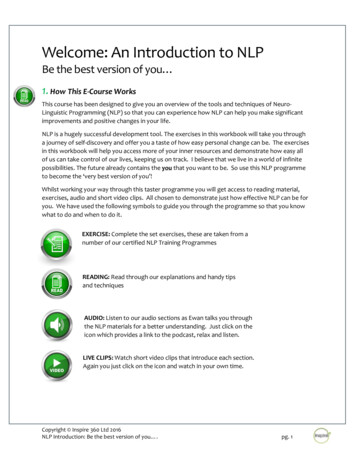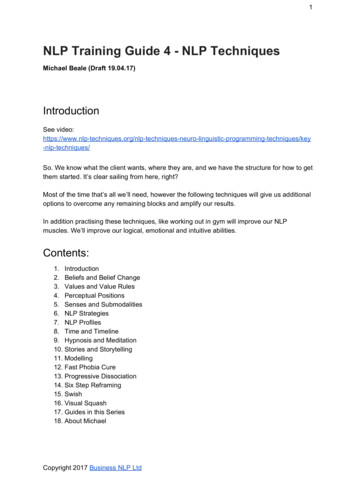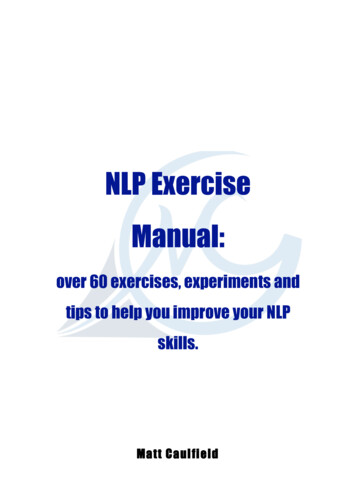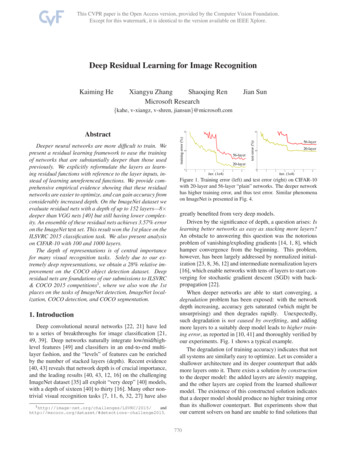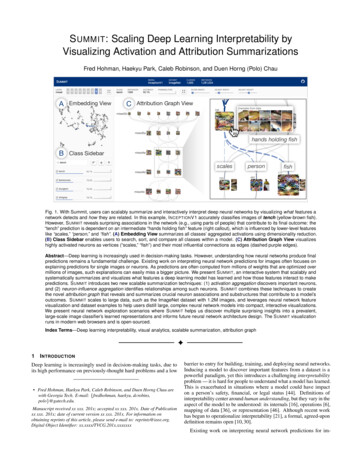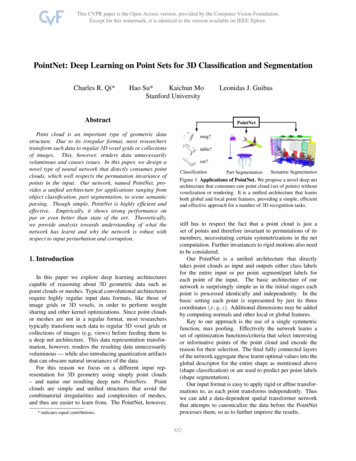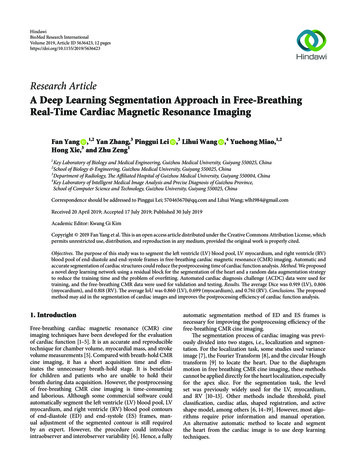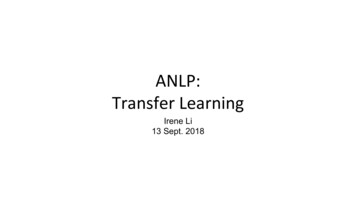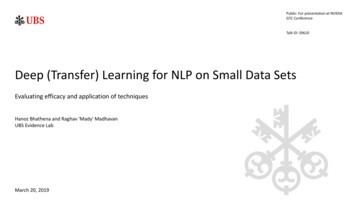
Transcription
Public: For presentation at NVIDIAGTC ConferencePublicTalk ID: S9610Deep (Transfer) Learning for NLP on Small Data SetsEvaluating efficacy and application of techniquesHanoz Bhathena and Raghav 'Mady' MadhavanUBS Evidence LabMarch 20, 2019
Public: For presentation at NVIDIAGTC ConferencePublicDisclaimerOpinions and views shared here are our personal ones, and not those of UBS or UBSEvidence Lab.Any mention of Companies, Public or Private, and/or their Brands, Products or Servicesis for illustrative purposes only and does not reflect a recommendation.
Agenda Problem & Motivation Transfer Learning Fundamentals Transfer Learning for small datasets in NLP Experiments Results Conclusion Future Work Q&A2
Problem Large (labeled) datasets has been the fuel that has powered the deep learning revolution of NLP However, in common business contexts, labeled data can be scarce Examples:– Financial documents– Legal documents– Client feedback emails– Classification from Clinical visits Issues:– Expensive to get labeling services– Data privacy concerns– Experimentation phase (unknown payoff; when to stop tagging?)3
MotivationEnable building deep learning models when small quantities of labeled data are availableIncrease usability of deep learning for NLP tasksDecrease time required to develop modelsDemocratize model development beyond NLP experts4
Deep learning with less labeled data Transfer learning Semi-supervised learning Artificial data augmentation Weak supervision Zero-shot learning One-shot learning Few shot learning .5
Deep Transfer Learning Introductionto solve another different, but somewhat related, taskUse a model trained for one or more tasksTransfer LearningPre TrainingLearningLearningData(Source elDataModel(Target Domain)After supervised learning — Transfer Learning will be the nextdriver of ML commercial success - Andrew Ng, NIPS 20166
Transfer Learning in Computer VisionSource: Stanford CS231N lecture slides: Fei-Fei Li & Justin Johnson & Serena Yeung7
Transfer Learning – General RuleSource: Stanford CS231N lecture slides: Fei-Fei Li & Justin Johnson & Serena Yeung8
So, what about Transfer Learning for NLP? Is there a source dataset like ImageNet for NLP? Does this dataset require annotations? Or can we leverage unsupervised learning somehow? What are some common model architectures for NLP problems that optimize for knowledge transfer? How low can we go in terms of data requirements in our target domain? Should we tune the entire pre-trained model or just use it as a feature generator for downstream tasks?9
Transfer Learning for NLP – Pre-2018 Word2Vec (Feature based and Fine-tunable) (https://arxiv.org/abs/1310.4546) Glove (Feature based and Fine-tunable) (https://nlp.stanford.edu/pubs/glove.pdf) FastText (Feature based and Fine-tunable) (https://arxiv.org/abs/1607.04606) Sequence Autoencoders (Feature based and Fine-tunable) (https://arxiv.org/abs/1511.01432) LSTM language model pre-training (Feature based and Fine-tunable) (https://arxiv.org/abs/1511.01432)10
Transfer Learning for NLP – 2018 and Beyond Supervised Learning of Universal Sentence Representations from NLI Data (InferSent) (https://arxiv.org/abs/1705.02364) ** Deep contextualized word representations (ELMo) (https://arxiv.org/abs/1802.05365) Universal Sentence Encoder (https://arxiv.org/abs/1803.11175) OpenAI GPT research-covers/languageunsupervised/language understanding paper.pdf) BERT: Pre-training of Deep Bidirectional Transformers for Language Understanding (https://arxiv.org/abs/1810.04805) Universal Language Model Fine-tuning for Text Classification (ULMFiT) (https://arxiv.org/abs/1801.06146) GLUE: A Multi-Task Benchmark and Analysis Platform for Natural Language Understanding om/nyu-mll/GLUE-baselines) OpenAI GPT 2 gemodels/language models are unsupervised multitask learners.pdf)** This was actually published in 201711
What is GLUE and how is our objective different? Because with exception of WNLI(and perhaps RTE), most of thesedatasets are still too large to createespecially for experimentalprojects in a commercial setting. Is it possible to create meaningfuldeep learning models forclassification on just a few hundredsamples?Source: Original GLUE paper (https://arxiv.org/abs/1804.07461)12
Deep contextualized word representations (ELMo) Generates context dependent word embeddings Example: the word vector for the word "bank" in the sentence "I am going to the bank" will be different from the vector for thesentence "We can bank on him" The model comprises of a character level CNN model followed by a L 2 layer bi-directional LSTM model Weighted average of the embeddings from char-CNN and the hidden vectors from the 2 layer bi-LSTM Language model pretraining on the 1B Word Benchmark Pre-trained model is available on Tensorflow-Hub and AllenNLP13
Universal Sentence Encoder Two types: Deep Averaging Network (DAN) and Transformer network Multi-task training on a combination of supervised and unsupervised training objectives Trained on varied datasets like Wikipedia, web news, blogs Uses attention to compute context aware word embeddings which are combined into a sentence level representation Pre-trained model is available on Tensorflow-Hub14
BERT Uses the encoder half of Transformer The input is tokenized using a WordPiece tokenizer (Wu et al., 2016) Training on a dual task: Masked LM and next sentence prediction The next sentence prediction task learns to predict, given two sentences A and B, whether the second sentence (B) comes afterthe first one (A) This enables the BERT model to understand sentence relationships and thereby a higher level understanding capabilitycompared to just a language model training Data for pre-training: BookCorpus (800mn words) English Wikipedia (2.5bn words) BERT obtains SOTA results on 11 NLP tasks in the GLUE benchmark15
BERT vs ELMo - ArchitectureSource: Original BERT paper16
Experiments: Setup Feature based learning: Only train the final layer(s) Finetune based learning: Fine tune all layers using a small learning rateTransfer learning training paradigms Baseline CNN (with and without pretrained Glove embeddings) ELMo Universal Sentence EncoderModels to evaluate BERT Mean, Standard Deviation of Out-of-Sample Accuracy after N trials No explicit attempt to optimize hyperparameters Some pre-trained model architecture will be well suited for all applications Either finetuning or feature mode will emerge a consistent winnerEvaluation CriteriaApriori Expectations17
Experiment 1: IMDB Rating Application– Sentiment classification model on IMDB movie reviews– Binary classification problem: positive or negative– 25,000 Training samples; 12,500 positive and 12,500 negative– 25,000 Test samples; 12,500 positive and 12,500 negative18
Experiment 1: IMDB Rating ApplicationNaïve baseline model: CNN with BatchNorm and Dropout WITHOUT pretrained Glove100 Trials eachMean Test AccuracyStd. Dev. Test %20%10%0.2%0%0%1002003004005006001000Training SizeUsing 25,000 training sample yields: 87.1%Source: UBS Evidence Lab19
Experiment 1: IMDB Rating ApplicationMore realistic baseline model: CNN with BatchNorm and Dropout WITH pretrained Glove100 Trials eachMean Test AccuracyStd. Dev. Test %70%0.3%68%66%0%1002003004005006001000Training SizeUsing 25,000 training sample yields: 89.8%Source: UBS Evidence Lab20
Experiment 1: IMDB Rating ApplicationUniversal Sentence Encoder: DANFine Tuning based Training – 10 Trials eachFeature based Training – 10 Trials eachStd. Dev. Test AccuracyMean Test AccuracyStd. Dev. Test AccuracyMean Test 8%1000%200300400500Training SizeUsing 25,000 training sample yields: 86.6%60010000%60%1002003004005006001000Training SizeUsing 25,000 training sample yields: 82.6%Source: UBS Evidence Lab21
Experiment 1: IMDB Rating ApplicationBERTFine Tuning based Training – 100 Trials eachMean Test AccuracyStd. Dev. Test AccuracyMean Test Accuracy90%Feature based Training – 10 Trials each5%4.7%Std. Dev. Test %100200300400500Training SizeUsing 25,000 training sample yields: 01000Training SizeUsing 25,000 training sample yields: 81.8%Source: UBS Evidence Lab22
Experiment 1: IMDB Rating ApplicationSummary of Experimental ResultsModelNaïve BaselineRealistic BaselineUSE - FTUSE - FBBERT - FTBERT - ��𝑡𝑒𝑑 𝐴𝑐𝑐𝑢𝑟𝑎𝑐𝑦 (1 𝑆𝑡𝑑𝑑𝑒𝑣)23
Experiment 2: HyperPartisan News Application– Given a news article text, decide whether it follows a hyperpartisan argumentation, i.e., whether it exhibits blind,prejudiced, or unreasoning allegiance to one party, faction, cause, or eb/)– Binary classification problem: Whether a news article is hyperpartisan or not– 642 Training samples; 50% hyperpartisan and 50% neutral– 129 Test samples; 67% hyperpartisan and 33% neutral24
Experiment 2: HyperPartisan News ApplicationNaïve baseline model: CNN with BatchNorm and Dropout WITHOUT pretrained Glove30 Trials eachMean Test AccuracyStd. Dev. Test %0%100200300400500600650Training SizeSource: UBS Evidence Lab25
Experiment 2: HyperPartisan News ApplicationMore realistic baseline model: CNN with BatchNorm and Dropout WITH pretrained Glove30 Trials eachMean Test AccuracyStd. Dev. Test ng SizeSource: UBS Evidence Lab26
Experiment 2: HyperPartisan News ApplicationUniversal Sentence Encoder: DANFine Tuning based Training – 30 Trials eachMean Test AccuracyFeature based Training – 30 Trials each80%78%Mean Test AccuracyStd. Dev. Test Accuracy79.1%8.8%10%Std. Dev. Test 64%2%1%62%0%100200300400Training Size50060065062%0%100200300400500600650Training SizeSource: UBS Evidence Lab27
Experiment 2: HyperPartisan News ApplicationELMoFine Tuning based Training – 30 Trials eachMean Test AccuracyFeature based Training – 30 Trials eachMean Test AccuracyStd. Dev. Test Accuracy78%5%Std. Dev. Test %100200300400Training Size50060065066%0%100200300400500600650Training SizeSource: UBS Evidence Lab28
Experiment 2: HyperPartisan News ApplicationBERTFine Tuning based Training – 30 Trials eachMean Test AccuracyFeature based Training – 30 Trials each90%9.8%Std. Dev. Test AccuracyMean Test AccuracyStd. Dev. Test %3%4%3%20%1.3%2%10%0%100200300400Training Training SizeSource: UBS Evidence Lab29
Experiment 2: HyperPartisan News ApplicationSummary of Experimental ResultsModelNaïve BaselineRealistic BaselineUSE - FTUSE - FBELMO - FTELMO - FBBERT - FTBERT - �𝑑 𝐴𝑐𝑐𝑢𝑟𝑎𝑐𝑦 (1 𝑆𝑡𝑑𝑑𝑒𝑣)30
Results Summary There is no clear winner between finetune mode and feature mode BERT, in finetuning mode, is the best transfer learning model for big and small training sizes Feature mode for BERT however is much worse, especially for low training sizes. BERT in finetune mode beats a CNN model on entire training set size:– 87.1% vs 92.5% for IMDB (current SOTA is 95.4% with ULMFit)– 81% vs 86% for News31
Conclusions Bad News:– No clear winner between finetune mode and feature mode– Not all transfer learning architectures provide a clear advantage over CNN Glove * Good News:– BERT with finetuning works well for transfer learning model for low data problems– Achieved 50x sample efficiency for IMDB versus Naïve baseline– Achieved 3x sample efficiency for News versus Naïve baseline– With a training set of 100-150 samples per label using BERT, we could achieve near equal accuracy tobaseline model using all available data– BERT achieves about 5-6% higher accuracy than baseline with all training data– Unsupervised language modeling on large datasets is a highly competitive method for pre-training*Robust hyperparameter tuning might make some improvements32
Future Work Apply concepts from ULMFit to BERT training More directed data selection procedures for incremental labeling Predicting when we have enough to the point of diminishing returns (on cost/benefit scale) How to make transfer learning work in the few-shot or zero-shot case33
Starter Code/Pre-trained Model Sources Baseline CNN Glove: esearch,https://nlp.stanford.edu/projects/glove/ ELMo, USE models: Tensorflow Hub https://www.tensorflow.org/hub BERT: BERT34
Q&A Raghav Madhavan: raghav.madhavan@ubs.com Hanoz Bhathena: hanoz.bhathena@ubs.com35
AppendixPage intentionally left blank36
Sequence Autoencoders & LM Pre-training Recurrent Language
Pre Training Data (Target Domain) Learning Algorithm Task Specific Model Transfer Learning After supervised learning — Transfer Learning will be the next driver of ML commercial success - Andrew Ng, NIPS 2016 Use a model trained for one or more tasks to solve another different, but somewhat related, task. 7 Transfer Learning in Computer Vision Source: Stanford CS231N lecture slides: Fei-Fei .
